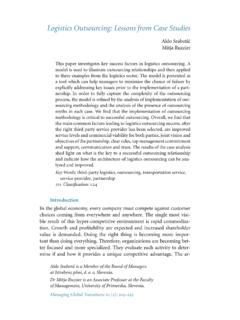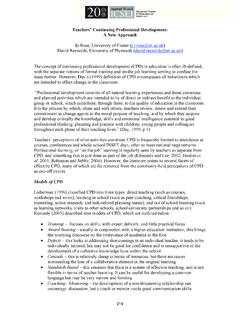Transcription of LeadershipCompetencies forManaging Diversity
1 Leadership Competencies for Managing Diversity Jan Visagie Herman Linde Werner Havenga The new understanding of Diversity involves more than increasing the number of di erent identity groups on the payroll. An important pro- posal is that the experience of Diversity in an organisation results from pervasive styles of management. This article dealt with the specific paradigms of Diversity management and leadership style theory used to address the research problem in the empirical study, namely Is Diversity management experience related to leadership styles or competencies?' The models of Diversity and inclusion indicators are used to examine the ex- perience of Diversity management. The population of this study into the experience of Diversity management is two thousand six hundred and sixty nine (2669) respondents. Leadership styles were obtained from four hundred and forty (440) leaders. The Cronbach alpha values were determined in order to indicate internal validity and reliability.
2 Key Words: Diversity management, engaging leadership style, experience, heroic leadership style, management, symbolic interactionism jel Classification: d740, l290, m120, j53. Introduction Diversity is a subject that can be very powerful and emotional for every- one who deals with it, either directly or indirectly. Diversity topics deal with issues of being di erent and alike, inspiration and perspiration, sad- ness and gladness, privilege and lack thereof, culture and religion, toler- ance and justice, and hatred and animosity. Diversity challenges and op- portunities impact all nations around the world to one extent or another (Bahaudin and Jatuporn 2009). The question could be asked, what exactly is Diversity management,'. why does management include it in their organisation objectives, and Dr Jan Visagie is an Associate Professor at the School of Human Resource Sciences, North-West University, South Africa. Dr Herman Linde is Program Leader Labor Relations at the School of Human Resource Sciences, North-West University, South Africa.
3 Dr Werner Havenga is a Senior Lecturer in the Department of Human Resource Management, University of Johannesburg, South Africa. Managing Global Transitions 9 (3): 225 247. 226 Jan Visagie, Herman Linde, and Werner Havenga how will it be measured? It may be taking the issue too far to claim that Diversity is the most talked about but the least implemented corporate objective. However, the fact remains that as a strategic objective, Diversity often constitutes the poor relations' and ranks low on managers' lists of priorities (Human 2005, 1). It is well documented that Diversity and Diversity management have any number of definitions, interpretations, applications and implica- tions. Is Diversity management, as some might say, becoming a clich , reformed a rmative action, a defining matter or something else? In any event, Diversity management remains a question of what rather than if (Bledsoe and Oatsvall 2008, 7). The existential present, the now,' on which we act, is dynamic and implies a past and future (Mead 1936).
4 Having presented the contextual realities for leadership and Diversity management, arising from the past and present, the specific interactive leadership style and Diversity man- agement theories were used to address the aim of this article ( What kind of leadership style do organisations need to developed to establish a pos- itive experience of Diversity management in order to continue to be suc- cessful?') and to propose a Diversity leadership competency model. Von Mises (1996, 42) stated that all actions are performed by individ- uals: A collective operates through the intermediary of one or several in- dividuals whose actions are related to the collective. It is the meaning . which the acting individual and those who are touched by the actions attribute to an action that determines its character.'. Blumer places primary importance on the foundation of human be- haviour through interaction with the self.' This specifically underlies ac- tions it is interaction, real or imagined, with others and the self that is the most important determinant of the behaviour of the individual (Harris 2005).
5 Mintzberg's (2004) engaging leadership style is required to establish a positive experience of Diversity management. This article specifically explains the interactive leadership style theory of McClelland and Burnham (1976), Burnham (2003) and Mintzberg (2004) and relies on empirical research. Robertson's (2004) five-factor model, inclusive of the paradigms of Thomas and Ely (1996; 2002), is used to examine the experience of Diversity management. The aim of the study is to determine the kind of leadership compe- tency styles for managers in organisations and to develop and establish a positive experience of Diversity management in order to continue to be successful. Managing Global Transitions Leadership Competencies for Managing Diversity 227. The specific objective of this article is to determine Diversity manage- ment experience in workplaces, whether the experience of Diversity dif- fered between race, gender and generational groups and whether this experience related to leadership style.
6 Leadership Competencies for Managing Diversity To be successful in today's market, companies need an extremely capable, flexible and dedicated workforce, a flexible and innovative management, and the capability to hold on to developed talent. To accomplish these objectives, the company needs a talented hr department. In addition to hiring the right people to carry out specific jobs, hr managers have to build up dedication and allegiance among the workforce (Manna and Morris 2008). Organisations of di erent sizes, structures, and purposes increase their breadth of search, learning capabilities, and resource access thereby reducing the threat of core rigidities in management. However, diverse organisations tend to have di erent goals, management styles, decision- making processes, and systems that cause communication and coordi- nation di culties (Jiang, Santoro, and Tao 2010, 1138). Dreachlin (2007) claimed that new era Diversity management tests leadership skills at a deep and personal level.
7 According to Barrett and Beeson (2002), who undertook extensive research into developing lead- ership competencies for competitive advantage, leadership competencies will change as the competitive environment changes. They predicted that five critical forces would shape leadership compe- tencies (requirements) in the future, namely (a) global competition, (b). information technology, (c) rapid and flexible organisations, (d) teams, and (e) di ering employee needs. Considering these, most organisations will not need the Lone Ranger' type of leader as much as a leader who can motivate and co-ordinate a team-based approach (Barrett and Bee- son 2002). This is consistent with the views of Mintzberg (2004), who believes an engaging interactive leadership style is required. In the future, the model of e ective leadership will be one of encouraging environments that un- lock the entire organisation's human asset potential (Hernez-Broomeand and Hughes 2006).
8 Barrett and Beeson (2002) furthermore identified four essential roles for meeting the business challenge of the future, and the career derailers'. who will matter most in the future. The four essential roles for meeting Volume 9 Number 3 Fall 2011. 228 Jan Visagie, Herman Linde, and Werner Havenga future business challenges, include master strategies,' change manager,'. relationship network building' and talent developers.' Intensified glob- alisation, the increasing use of technology, and public scrutiny of the in- tegrity of leaders influence the role of the leader (Hernez-Broome and Hughes 2006). In essence, Crossan and Olivera (2006) opined that, within the context where organisational boundaries have become less defined and compe- tition dictates radical change, the hierarchical leadership approach has become outdated Distributed leadership has become necessary and no one can manage it all' (Crossan and Olivera 2006, 4). The overarching interactive competencies of leaders gain further sig- nificance when evaluating Gentry and Leslie's (2007) research into lead- ership requirements.
9 The leadership competencies most favoured in or- ganisations included building and mending relationships,' bringing out the best in people' and listening.' Vision, inspiration and communica- tional goals were regarded as further important competencies for people in leadership positions. Gentry and Leslie (2007) furthermore concluded that enhancing busi- ness skills and knowledge was not regarded as very important for lead- ership development. Leslie et al. (2002) identified five characteristics of successful global leaders, namely context, specific knowledge and skills, inquisitiveness, personal character, connecting, and integrity. Leslie et al. (2002) regarded duality' (the capacity for managing uncertainty and the ability to balance) and savvy' (practical understanding of business and organisation) as important. Goleman, Boyatzis, and McKee's (2002, 38). similar contention was that leadership operates best through emotion- ally intelligent leaders who create resonance.
10 '. Kets de Vries and Mead (1992) submitted that the influences on lead- ership qualities as well as the ability to adapt culturally result from child- hood background and psychological development. In this study, Kets de Vries and Mead (1992) indicated that in addition to standard technical competence and business experience, global managers would need to in- teract e ectively with people who are di erent.' This could be learnt through developmental factors, such as cultural Diversity in the family, early international experience, bilingualism, self-confidence, hardiness, envisioning, cultural studies and international environmental studies. Chang and Thorenou (2004) commented that current literature refers to cognitive factors that may a ect the ability of managers to manage across cultures. These cognitive factors include the ability of leaders to Managing Global Transitions Leadership Competencies for Managing Diversity 229. manage stereotypes.









